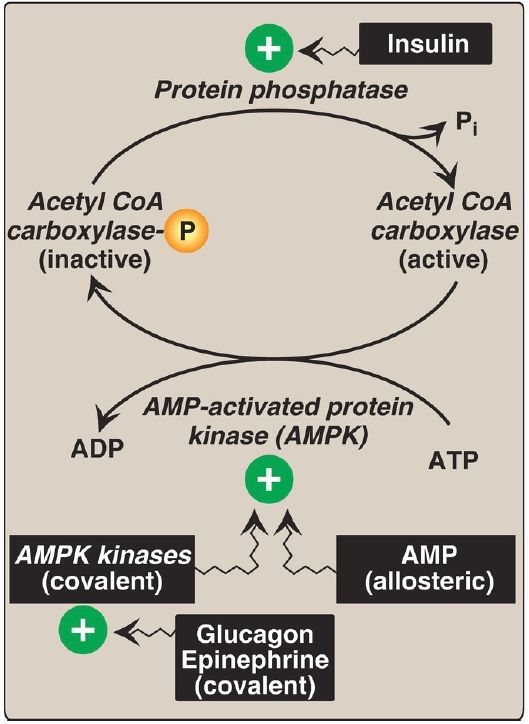


 النبات
النبات
 الحيوان
الحيوان
 الأحياء المجهرية
الأحياء المجهرية
 علم الأمراض
علم الأمراض
 التقانة الإحيائية
التقانة الإحيائية
 التقنية الحيوية المكروبية
التقنية الحيوية المكروبية
 التقنية الحياتية النانوية
التقنية الحياتية النانوية
 علم الأجنة
علم الأجنة
 الأحياء الجزيئي
الأحياء الجزيئي
 علم وظائف الأعضاء
علم وظائف الأعضاء
 الغدد
الغدد
 المضادات الحيوية
المضادات الحيوية|
Read More
Date: 26-9-2021
Date: 30-10-2021
Date: 7-12-2021
|
Fatty Acid Synthesis (Acetyl CoA carboxylation to malonyl CoA)
The energy for the carbon-to-carbon condensations in fatty acid synthesis is supplied by the carboxylation and then decarboxylation of acyl groups in the cytosol. The carboxylation of acetyl CoA to malonyl CoA is catalyzed by acetyl CoA carboxylase (ACC) (Fig. 1).
ACC transfers carbon dioxide (CO2) from bicarbonate  in an ATP-requiring reaction. The coenzyme is biotin (vitamin B7), which is covalently bound to a lysyl residue of the carboxylase . ACC carboxylates the bound biotin, which transfers the activated carboxyl group to acetyl CoA.
in an ATP-requiring reaction. The coenzyme is biotin (vitamin B7), which is covalently bound to a lysyl residue of the carboxylase . ACC carboxylates the bound biotin, which transfers the activated carboxyl group to acetyl CoA.

Figure 1: Allosteric regulation of malonyl coenzyme A (CoA) synthesis by acetyl CoA carboxylase. The carboxyl group contributed by bicarbonate  is shown in blue. Pi = inorganic phosphate; ADP = adenosine diphosphate.
is shown in blue. Pi = inorganic phosphate; ADP = adenosine diphosphate.
1. Acetyl CoA carboxylase short-term regulation: This carboxylation is both the rate-limiting and the regulated step in fatty acid synthesis (see Fig. 1). The inactive form of ACC is a protomer (complex of ≥2 polypeptides). The enzyme is allosterically activated by citrate, which causes protomers to polymerize, and allosterically inactivated by palmitoyl CoA (the end product of the pathway), which causes depolymerization. A second mechanism of short-term regulation is by reversible phosphorylation. Adenosine monophosphate–activated protein kinase (AMPK) phosphorylates and inactivates ACC. AMPK itself is activated allosterically by AMP and covalently by phosphorylation via several kinases. At least one of these AMPK kinases is activated by cyclic AMP (cAMP)–dependent protein kinase A (PKA). Thus, in the presence of counterregulatory hormones, such as epinephrine and glucagon, ACC is phosphorylated and inactive (Fig. 2). In the presence of insulin, ACC is dephosphorylated and active. [Note: This is analogous to the regulation of glycogen synthase .]

Figure 2: Covalent regulation of acetyl CoA carboxylase by AMPK, which itself is regulated both covalently and allosterically. CoA = coenzyme A; ADP and AMP = adenosine di- and monophosphates; = phosphate; Pi = inorganic phosphate.
2. Acetyl CoA carboxylase long-term regulation: Prolonged consumption of a diet containing excess calories (particularly high-carbohydrate, low-fat diets) causes an increase in ACC synthesis, thereby increasing fatty acid synthesis. A low-calorie or a high-fat, low-carbohydrate diet has the opposite effect. [Note: ACC synthesis is upregulated by carbohydrate (specifically glucose) via the transcription factor carbohydrate response element–binding protein (ChREBP) and by insulin via the transcription factor sterol regulatory element–binding protein-1c (SREBP-1c). Fatty acid synthase is similarly regulated. Metformin, used in the treatment of type 2 diabetes, lowers plasma TAG through activation of AMPK, resulting in inhibition of ACC activity (by phosphorylation) and inhibition of ACC and fatty acid synthase expression (by decreasing SREBP-1c). Metformin lowers blood glucose by increasing AMPKmediated glucose uptake by muscle.



|
|
|
|
التوتر والسرطان.. علماء يحذرون من "صلة خطيرة"
|
|
|
|
|
|
|
مرآة السيارة: مدى دقة عكسها للصورة الصحيحة
|
|
|
|
|
|
|
العتبة العباسية المقدسة تُطلق فعّاليات مؤتمر ذاكرة الألم في العراق
|
|
|